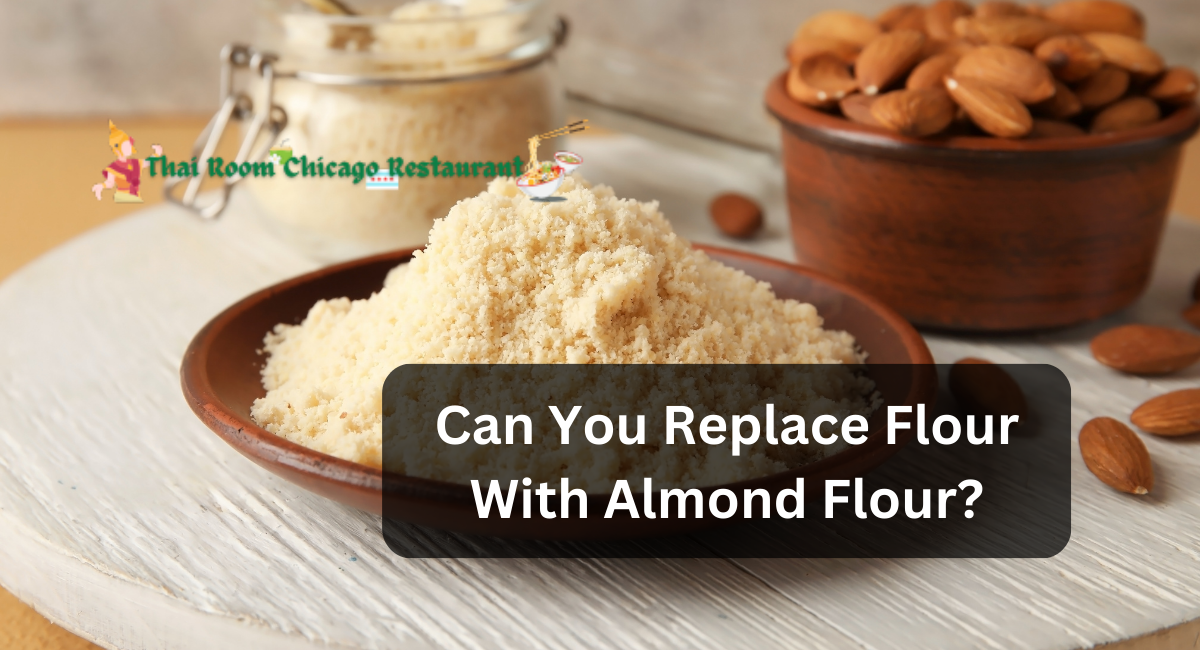Flour is used in many recipes, from traditional bread and pizza dough to delicate pastries and cakes.
However, many people are looking into flour substitutes for various reasons, including dietary preferences and allergies.
Almond flour is one such popular substitution. In this article, we’ll look at how to replace ordinary flour with almond flour and the benefits and drawbacks of doing so.
Can You Replace Flour With Almond Flour?
Yes, you may regularly use almond flour for all-purpose flour in a variety of recipes; however, there are a few essential things to keep in mind while making this switch:
Texture And Flavor
Compared to all-purpose flour, almond flour has a distinct difference in both its texture and its flavor.
Since almond flour is made from ground almonds, it is naturally free of grains and has a flavor that is grainy with a hint of nuttiness.
Additionally, it has a propensity to be more dense and wet. This may be successful in certain recipes, such as those for specific baked items and crusts, but it is possible that it will not work in others.
Gluten-Free
Because almond flour does not contain gluten, it is a great option for people who have celiac disease or gluten sensitivity.
However, since it does not include gluten, it is possible that it will not be able to produce the same structure and elasticity in recipes like bread that depend on gluten for their texture.
Substitution Ratios
Due to the fact that almond flour and all-purpose flour have quite different consistencies, the ratio that you use to substitute one for the other is often not one-to-one.
When replacing all-purpose flour with almond flour, the normal ratio is one-fourth to one-third cup almond flour for each cup all-purpose flour.
This ratio may need to be adjusted based on the recipe’s specifics and your personal tastes.
It is recommended that the amount of almond flour be reduced to begin with and then increased, if necessary, in order to reach the ideal consistency.
Leavening Agents
Because almond flour does not interact with leavening agents (baking powder or baking soda) in the same way that wheat flour does, recipes that call for almond flour may need to have the leavening agents (baking powder or baking soda) adjusted in order to be successful. You might need to try a few different things before you find the optimal equilibrium.
Binding Agents
Because almond flour does not contain gluten, it is possible that additional binding agents, such as eggs or xanthan gum, will be required in certain recipes in order to ensure that the baked goods come out looking and tasting as they should.
Browning
Because almond flour has a greater propensity to brown more quickly than wheat flour, you may find that you need to lower the oven temperature or shorten the cooking time in order to prevent excessive browning.
Moisture Content
Because almond flour has a higher fat content than all-purpose flour, baked items made with almond flour tend to have a higher moisture content. Be aware that the texture will be different in this case.
How To Use Almond Flour In Place Of Flour?
Here are some baking tips and strategies for using almond flour:
(1) Take Accurate Measurements
When measuring almond flour, do not pack it. It should just fit in your measuring cup. If you use too much almond flour, your baked items will be overly dense.
I simply scoop almond flour from the bag or container and use a butter knife to remove any excess. 1 cup blanched almond flour weights 4 ounces when measured by weight.
(2) Make Use Of Less Flour
When adapting a wheat flour or gluten-free flour recipe to almond flour, you will need less almond flour per cup of conventional flour.
When baking with yeast (such as bread, rolls, and pizza), use up to 1/3 cup almond flour for every cup wheat or gluten-free flour.
Replace 1/4 of the flour (25%) with almond flour in non-yeast baking (think cookies, scones, cake, biscuits, and muffins). If a recipe calls for 1 cup of flour, substitute 3/4 cup ordinary flour and 1/4 cup almond flour.
You’ll notice that baked items using even a small amount of almond flour stay moist and soft for longer and have a better flavor.
Even a few teaspoons of gluten-free flour in place of almond flour in a cake mix will make a significant impact in the texture of the cake.
(3) Use In Cookies Rather Than Cakes
I don’t recommend using almond flour alone to make cakes and bread since it lacks the desired light and airy quality.
However, because cookies and brownies do not require a light and fluffy texture, using almond flour as the sole flour could work. French macarons are a single biscuit composed entirely of almond flour that works!
(4) Use As An Add-On
Gluten-free baked items have a tendency to become dry and crumbly after a day.
However, replacing 1-2 tablespoons of flour in a recipe with almond flour reduces the rate at which a gluten-free baked dish dries.
Almond flour’s high-fat content works wonders for keeping cakes and breads moist for days.
(5) Include A Binder
When baking using almond flour, you’ll need a binder like xanthan gum, guar gum, or psyllium husk to give your baked goods structure.
When no gluten (the “glue” of a baked dish) is present, these binders are employed in gluten-free flour mixes to assist “bind” the flour together.
Even 1/4 teaspoon of xanthan gum per 1 cup of flour can make a big difference, though bread recipes call for 2 teaspoons of xanthan gum per cup of flour.
(6) Reduce The Cooking Time And Temperature
Almond flour-based baked items bake faster. Lower the temperature by 25 degree and cook for one-fourth the time when converting a wheat flour recipe to almond flour (keep an eye on your baked items to ensure they don’t burn).
(7) Allow To Cool In The Pan
Almond flour baked items are moister and more prone to falling apart after baking. Allow baked items made with almond flour to cool completely on a baking sheet or pan before removing them. This will give them time to stiffen up as they cool and make them more likely to retain their structure.
Finally, almond flour is a versatile and nutritious substitute for ordinary wheat flour. It’s a great option for anyone who want to cut carbs, eat gluten-free, or add a nutty taste to their baked goods. However, it is critical to utilize almond flour with caution, taking into account its particular features as well as the specific needs of your recipes.
So, can almond flour be used in place of flour? In many circumstances, the answer is yes. Almond flour may offer up a world of culinary possibilities with the appropriate recipes and a little experimenting.
Thanks for reading. I hope you find it helpful.










